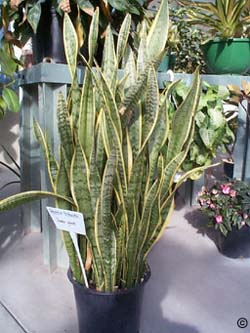No matter the common name used, “snake plant” or “mother-in-law’s tongue”, this succulent houseplant has earned a reputation for being tough. Its stiff, upright sword-shaped leaves make Sansevieria trifasciata a popular vertical accent in houseplant groupings. It prefers a warm location with medium to bright indirect light but will adapt to low light conditions. In lower light, any markings or variegation will be less pronounced.
How much should I water a snake plant?

Native to Nigeria, Sansevieria is a succulent plant that requires only enough water to keep the soil from drying out completely during the fall and winter when active growth slows. During spring and summer when growth is more active, it should be watered thoroughly then let dry slightly between waterings. The leathery leaves grow from rhizomes that form a rosette in the container. Care should be taken to not pour water into the center of the rosette. Plants can get top heavy and are often grown in clay or ceramic pots rather than plastic to provide stability.
How can I start a new plant from a shoot?
New shoots arise from rhizomes and may be left to fill the container or can be divided out for a new plant. A new plant can also be started by cutting the leaves into horizontal sections and sticking them into a container filled with potting mix. The container should be placed in a clear plastic bag with a few holes to increase the humidity and set in a warm area with medium light. The sections will root in a few weeks.
What are the different types of snake plants?
Sansevierias are available in a green form that has a slight marbling to the leaves as well as a variegated form that features bright yellow stripes along the edges of the leaves. A compact variety often referred to as a bird’s nest sansevieria is also available.
For additional information, see the Planttalk Colorado™ scripts:
For more information, see the following Colorado State University Extension fact sheet(s).



